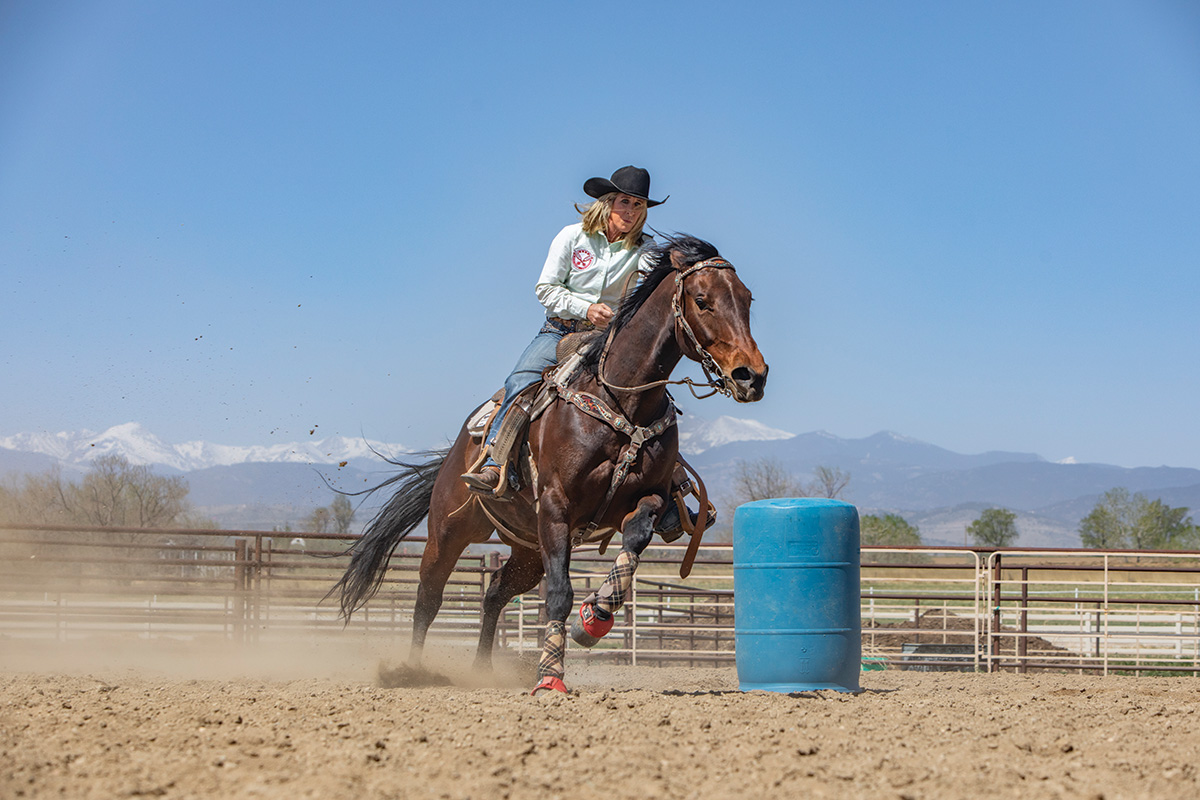Barrel racing isn’t only about going fast. To round the three barrels in a barrel racing pattern with precision as well as a fast time, classical horsemanship skills apply.
Barrel racing coach and competitor Kelly Kennedy-Joseph shares how three classical horsemanship skills apply to her sport. As she likes to say, “smooth is fast.” You’ll need to have your horse listening to your body before you add speed.
“Even if you keep your horse at half speed, but have his attention and connection, you’ll do better than someone who runs but has little control,” Kennedy-Joseph says. “If you go fast without connection and balance, you’ll pull too much and lose your balance. Your hands are a guide tool, but your body position tells the horse where to be.

“Knowing that you can get the horse’s hip driven up underneath him is important,” she continues. “When you sit down, you want him to slow down and sit down, too. You want to keep his shoulder up and move his nose tipped in. Barrel racing is about how you place the horse’s body and asking him to respond to your body. You want a connection with the horse, and not to rely only on rein cues.”
Collection Matters in Barrel Racing
Just as a dressage rider can cue a horse to round and work in a frame, Kennedy-Joseph says she wants her horses to frame up. While barrel racing participants may not need the amount of collection required for dressage competition, the same horsemanship principles apply.

She explains that barrel horses need to know how to lift their rib cages and use their entire bodies in order to move around the barrels with balance. She works on the classic horsemanship skill of collection and getting her barrel racing horse to round when she’s warming up away from the barrels.
To ask the horse to use his body well, Kennedy-Joseph says she rolls her pelvis under slightly and uses her core. The horse should match what she’s doing in her body. She tells her students to imagine pressing their belly buttons toward their backbones.

“You can’t expect a horse to turn at full speed,” Kennedy-Joseph says. “You need your horse to rate his speed to get around the barrel safely. Make sure the horse is slowed down so he knows where to put his feet.”
If your horse responded well to collecting when warming up, he’ll respond to your body aids and know to listen when you use the same body cue at the barrel.

“When I roll my hips under, I want my horse to slow slightly and collect as well,” Kennedy-Joseph says. “I want my horse to know that when I tip my pelvis under, that means he should get his legs up underneath him, too. As you’re leaving the barrel, move your pelvis forward. That’s a signal to your horse to extend his strides and move out.”
Horsemanship Skills When Barrel Racing
When approaching a barrel, it’s time to put all the skills together. You’ll move straight ahead toward the barrel, find the perfect place to slow down for your horse, shift your pelvis under and slow your speed for a turn that’s in control.
It’s OK to roll your shoulders under slightly while barrel racing, even if that doesn’t feel like the horsemanship position you’re used to. You’ll need to lower your center of gravity around the barrel. Keep your hands low and bend your elbow slightly in the direction of your turn. This will push your horse up into the turn and guide him around the turn. Practice this move near a barrel or as you ride around the arena without a barrel in sight.
“It shouldn’t be a pulling war to get around the barrel,” Kennedy-Joseph says. “Instead, you’ll slow, then use your outside leg to support your horse around the barrel. It’s not kicking, it’s guiding. Then once you get around the barrel, wait for him to finish the turn. Let him take you around the barrel. Then, square your shoulders and tip your pelvis forward so that you can move out to the next barrel.”

Kennedy-Joseph says horses differ slightly when it comes to when to give this slow-down-and-rounding cue in the line to the barrel. If you’re riding a horse that runs freely, you’ll want to sit down and cue your horse to slow and collect a few strides before the barrel.
If you have a horse that will turn sharply, like a horse that was trained for cow work, you’ll need to roll your pelvis under (sitting on your pockets) and ride to the barrel more closely before you ask him to round and turn.

If your horse listens to you, you’ll be able to choose when to speed up and when to rate and slow down to get around the barrel.
“It’s not about going fast at all costs,” Kennedy-Joseph says. “It’s about choosing your speed and staying in control.”
Meet the Barrel Racing Trainer
Kelly Kennedy-Joseph has been active in barrel racing since she qualified for Little Britches Rodeos. She now coaches riders from her Berthoud, Colo., facility and races at the professional level nationwide.
This article about using horsemanship skills in barrel racing appeared in the September 2022 issue of Horse Illustrated magazine. Click here to subscribe!






